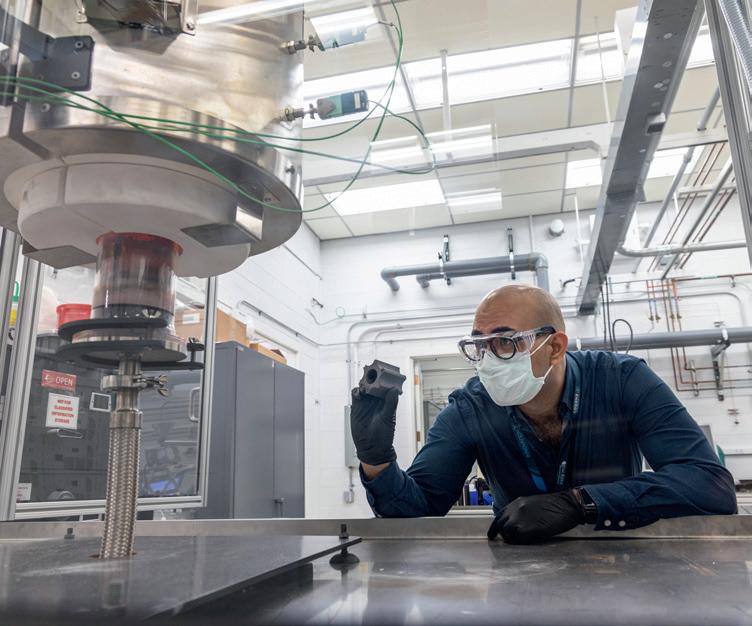
4 minute read
AMGTA’S GREEN MISSION
AMGTA’S GREEN MISSION Sherri Monroe [SM], Executive Director at the Additive Manufacturer Green Trade Association (AMGTA), on the importance of data and transparency in sustainability.
TCT: What compelled you to join the AMGTA? SM: This role, when I was fi rst approached, really intrigued me. It really made use of my background and my interests. I've worked for a couple of very large non-profi ts in the US so I have that experience of bringing together a broad group of stakeholders around a common cause and understanding their sometimes competing objectives. I also have a background in the for-profi t side and in innovations. So this is very much like that, not only in the fact that this is a new organization so there's a lot happening and a lot of wheels turning, but also that innovation side of new technology and getting that out there and technology and getting that out there and helping a broader audience understand helping a broader audience understand the value and the potential. the value and the potential. TCT: You’ve previously said ‘AM has TCT: You’ve previously said ‘AM has the potential to be transformational the potential to be transformational in how we sustainably manufacture.’ in how we sustainably manufacture.’ Can you elaborate? Can you elaborate? SM: AM has been around for many AM has been around for many years but really is coming into a years but really is coming into a new stage of life where we're going new stage of life where we're going beyond just using it for things like beyond just using it for things like prototyping, which is always going prototyping, which is always going to be a big part of it because of how to be a big part of it because of how eff ective that is, but moving beyond eff ective that is, but moving beyond simply making the same part that simply making the same part that was made traditionally and making was made traditionally and making that through additive. Now, there are that through additive. Now, there are certainly instances where that provides certainly instances where that provides huge value but I think where we're really huge value but I think where we're really going to see this next stage is where going to see this next stage is where we're leveraging the power of AM we're leveraging the power of AM design. The organizations that are able design. The organizations that are able to do that now and leverage that to do that now and leverage that are really seeing huge gains and are really seeing huge gains and so I think it really has the so I think it really has the potential for really transforming the manufacturing landscape. I think we're going to see new processes, new supply chains, new systems, new products, and it's really going to be a matter of fi nding those best uses.
TCT: We’ve recently seen more emphasis on LCAs in AM. What do you think this says about the industry’s commitment to sustainability? SM: Talk is cheap, as they say, and actions really are where it's at. The work that 6K and Materialise and others are doing is so important because it provides information but it also shows the transparency involved. Transparency is critical because transparency leads to credibility and if you're making claims or suggesting that things are more sustainable, you really need to be able to demonstrate that. Part of that process is actually defi ning what the lifecycle is. So how far back do you go? And how far out do you go in the life and the end of life of this product? So really studying that full lifecycle because the gains are in diff erent places than it would be through traditional manufacturing.




TCT: There’s a worry around ‘greenwashing’ in AM. Where do you think the biggest challenges or unknowns lie? SM: Whether it's looking in the hearts of an individual or looking into the heart of a corporation, sometimes it's hard to assess what their motivations are. I think we all know that there are companies that simply want something they can put in a paper or put on their website and say ‘we're green’ and move on about their business, while other organizations truly are committed to this. Sometimes those fi rst steps that companies make may look like greenwashing but it may just be their fi rst steps. They went for a couple of easy wins. What can we do quickly, easily? Why wouldn't you do that? The low hanging fruit, let's go there fi rst. So I think we have to be careful in labelling some of those things as greenwashing when it just may be, they're getting started. Let's recognize that, let's applaud that. Let's assist them, how can we help them share learning so that they can move further?
What I see in our membership is companies that are truly committed to this, this is not something that's being forced on them, that they see this as a strategic benefi t.
Listen to the interview in full: mytct.co/SherriQA
[Editor: Answers have been edited for brevity and clarity.]










